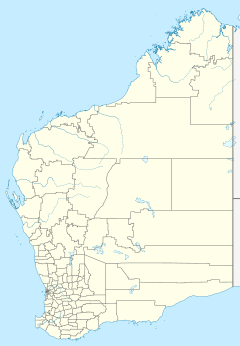24°23.728′S 113°24.597′E / 24.395467°S 113.409950°E

Quobba Station, most commonly referred to as Quobba, is a pastoral lease that operates as a sheep station in Western Australia. It was originally owned by Charles Augustus Fane and Charles Eugene Fane, who named it Point Charles.
Description
editThe property is situated approximately 60 kilometres (37 mi) north of Carnarvon and 144 kilometres (89 mi) south of Coral Bay at the southern tip of the Ningaloo Reef Marine Park[1] in the Gascoyne region. It is bounded by Boolathana Station and Lake Macleod to the east and the south, Gnaraloo to the north, and the Indian Ocean to the west.[1] The property is the most westerly station in Australia.[2]
The station has a boundary that runs north to south along the coast for a length of 180 kilometres (112 mi) and has a width of between 10 and 12 kilometres (6.2 and 7.5 mi). The area is composed of coastal rangeland vegetated in saltbush, karara and buffalo grass.[3]
History
editQuobba was established in 1898 by Charles Augustus Fane and currently occupies an area of 187,000 acres (76,000 ha).[1][4] The station was previously known as Point Charles Station after Charles Augustus Fane,[5] who transferred the ownership to Charles Eugene Fane and Dan Powell in 1909.[6] French and Baston acquired the station and the sheep from Charles Eugene Fane in 1923.[6]
The property was owned by George Baston and Leonard French in 1923. In 1925, over 8,000 sheep were shorn at Quobba.[7] In 1929 French died following a long illness.[8] Baston died in 1940[9] and left the property to his son Keith.[10]
In 1941 following the battle between the German auxiliary cruise Kormoran and the Australian cruiser HMAS Sydney, survivors from Kormoran came ashore in a 46-man cutter near 17-Mile Well and a 57-man lifeboat near Red Bluff.[11][12] Staff at Quobba rounded up both groups that had made landfall, who did not resist capture.[11]
The Meecham family acquired the property in 1977[13] and switched from rearing merino sheep for wool to damara sheep for meat. As of 2015[update] the property has a flock of approximately 10,000 damaras.[1]
In 2015 the station owners had to renegotiate the lease agreement with the state government, including having the government excise sections of pastoral land along the world-heritage-listed Ningaloo Coast from the property, for conservation and tourism ventures.[14]
Tourism
editTourism and recreational activities, particularly fishing and surfing, have progressively increased since the 1970s.[13] As of 2015[update], tourism accounted for 20% of the station's income. Attractions around the property include Ningaloo Reef, blowholes, the wreck of the bulk carrier Korean Star and a memorial cairn to HMAS Sydney. The station provides a variety of accommodation and a shop at Red Bluff.[3]
Surfing
editRed Bluff Point is a popular surfing spot with a left-hand break over the reef and waves of 1 to 12 feet (0.30 to 3.66 m).[15] In 2012, a surfer survived a shark attack there, and was rescued by other surfers.[16][17]
See also
editReferences
edit- ^ a b c d "Quobba Station, Carnarvon, Western Australia – History". 2015. Retrieved 19 December 2015.
- ^ "Pastoral Pars". Sunday Times. Perth. 26 October 1924. p. 26. Retrieved 20 December 2015 – via National Library of Australia.
- ^ a b Megan Broad (12 August 1999). "Tourism takes on bigger role at Quobba station". Farm Weekly. Fairfax Media. Retrieved 20 December 2015.
- ^ "Surf the waves at Red Bluff". Getaway. ninemsn. 3 December 2009. Retrieved 19 December 2015.
- ^ "Pastoral Pars". Sunday Times. Perth. 19 October 1924. p. 25. Retrieved 20 December 2015 – via National Library of Australia.
- ^ a b "Government Gazette" (PDF). State Library of Western Australia. 10 December 1909. Retrieved 10 December 2019.
- ^ "Pastoral Pars". Sunday Times. Perth. 22 November 1925. p. 8 S. Retrieved 20 December 2015 – via National Library of Australia.
- ^ "Obituary". The Northern Times. Carnarvon, Western Australia. 7 November 1929. p. 2. Retrieved 20 December 2015 – via National Library of Australia.
- ^ "Funeral". The Northern Times. Carnarvon, Western Australia. 12 July 1940. p. 2. Retrieved 20 December 2015 – via National Library of Australia.
- ^ "Three missing in small aircraft". The West Australian. Perth. 1 February 1952. p. 1. Retrieved 20 December 2015 – via National Library of Australia.
- ^ a b Frame, Tom (1993). HMAS Sydney: Loss and Controversy. Rydalmere, NSW: Hodder & Stoughton. p. 6. ISBN 0-340-58468-8. OCLC 32234178.
- ^ Olson, Wesley (2000). Bitter Victory: The Death of HMAS Sydney. Nedlands, WA: University of Western Australia Press. p. 40. ISBN 1-876268-49-2. OCLC 45722719.
- ^ a b Sean Murphy (12 July 2009). "Quarrel Coast". Landline. Australian Broadcasting Corporation. Retrieved 28 December 2018.
- ^ Lucie Bell (29 May 2015). "Five weeks and counting: Negotiations ongoing as Western Australia's pastoral lease rollover approaches". Australian Broadcasting Corporation. Retrieved 19 December 2015.
- ^ "Red Bluff, Australia". Wannasurf. 2015. Retrieved 20 December 2015.
- ^ Nicole Cox; Phil Hickey (30 August 2012). "Shark attack survivor Jon Hines resting after surgery". Perth Now/Sunday Times. News Corp Australia. Retrieved 21 December 2015.
{{cite web}}: CS1 maint: multiple names: authors list (link) - ^ Dan Proudman (3 November 2012). "1000 stitches but shark survivor Jon Hines set to fight on". Newcastle Herald. Fairfax Media. Retrieved 20 December 2015.
